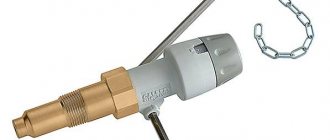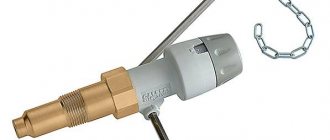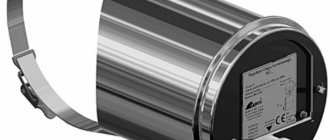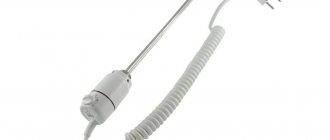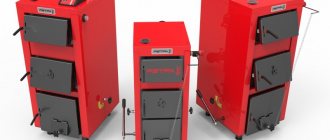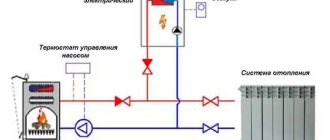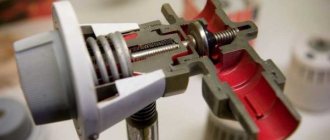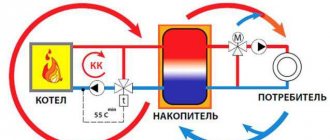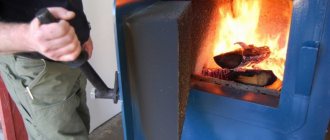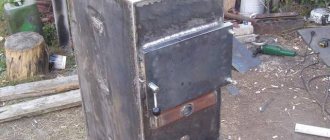To control the boiler and the entire heating system, special elements are provided that reduce energy costs for heating, and also help create an optimal temperature regime and at the same time prevent overheating of the room. These elements include a thermostat for a heating boiler. The temperature regulator allows you to save up to 20% of fuel resources, and by what means, we will tell you in this review.
A high-quality thermostat significantly reduces the cost of fuel raw materials
Thermostat for a heating boiler: temperature regulator or more?
There are several types of boilers. These are gas, solid fuel, and electric models. The material used to manufacture such equipment is cast iron or steel. Temperature control and adjustment is carried out using a special thermoelement. This equipment is a metal structure. As a result of thermal expansion, the position of the lever that moves the damper changes. To allow the combustion to grow, the damper is opened slightly. Newer designs include controllers that can regulate air flow.
Thermostatic draft regulator for solid fuel boiler
The most commonly used gas models are single-circuit and double-circuit. Some models have separate room thermostats for a gas boiler for a circuit with hot water supply and a heating circuit.
Electrical devices are distinguished by high efficiency and simple connections. In such designs there is protection against overheating and temperature control. Using a mechanical timer, various methods of temperature control are made. More often, the unit simply turns on/off when the temperature drops/exceeds. But it is also possible to set a specific switching time.
Helpful information! Mechanical devices have a round dial. To set the on time you need to turn the dial. Such devices are easy to adjust.
Description of traction force
This parameter depends on many factors, including:
- weather;
- chimney section;
- gas temperature.
All this can affect the operation of the device, so specific conditions must be considered individually. Another parameter that may escape the attention of consumers, but has a great influence on traction force, is the type of equipment. When using a gas device, the thrust force may change slightly, but the final value is stable. This is due to the fact that the flue gases have almost the same temperature.
The deviation occurs only when the chimney warms up, and the value changes briefly. Solid fuel equipment shows different data. It is impossible to judge the influence of models on traction. This is due to the use of different types of fuel. The heterogeneity of indicators also depends on the type of solid fuel boiler.
Types of control devices
Thermostats for heating boilers with the option of temperature control are divided into several types:
- mechanical models with one function;
- programmable models with a large range of auxiliary settings.
Also, similar designs are wireless and wired. Thermostats are installed in the selected location, a temperature sensor is connected and connected to the control device.
Design diagram of the control device
Note! Thermostats must be provided with constant air access to prevent overheating. It is also not recommended to install electrical appliances nearby.
Selecting a room programmable device
The option of an electronic temperature sensor for a heating boiler helps you select the appropriate temperature mode and change it at your discretion. The room thermostat sets the set values every day. Some setpoint values can be programmed, for example when day turns to night.
Such controllers have additional options. For example, a function that allows you to stop heating for a while and then resume it. You can also change the programmable temperatures for the duration of the configured periods. Another useful option is the ability to change the heating intensity.
Room type regulator
Thermostat as a central element
The central thermostat for the heating boiler (temperature regulator) is located at a certain distance from the heating unit and allows you to turn off and turn on equipment throughout the house.
Installation diagram of thermostats in the heating system
Related article:
Thermostat for heating radiator. What task does this device perform and what is its advantage? What is the operating principle and correct installation? Prices also matter. More details in a special publication.
Models from previous years are connected directly to the heating unit by wires, while more modern designs are distinguished by remote control. The latest devices are mounted in dual-circuit units Beretta, Ferroli and AOGV. Room control mechanisms for boilers of the Protherm and Gsm brands are popular. They differ in their dilatometric mechanism.
Protherm equipment models
Room devices stop heating when necessary. They monitor the air temperature and turn on the heating when the temperature drops. The best place for a microcontroller is considered to be the bedroom and living room.
Installing a controller will allow you to obtain accurate data on the microclimate of the room
Helpful information! The recommended temperature for the thermostat is 20 degrees, and in the children's room - 21-22 degrees. At night, the temperature can vary from 19 to 21 degrees.
Thermostatic valves for regulation
Such a device allows you to create a certain coolant temperature by mixing the forward and return flows. The device helps control temperature values by changing the flow of hot water through the battery. In this case, the mechanism controls the supply of hot water through the battery, but not through the boiler. It is installed in any room where you need to maintain a certain temperature.
Thermostatic valve design using the example of a specific model
Recommendations for choosing a device
Oddly enough, you can still find budget models of wood-burning heaters on sale that are not equipped with any automation. Most of them have in the basic configuration only a sleeve mounted inside the water jacket. To automate such a boiler, you will have to buy and install a draft regulator yourself.
To choose the right mechanical regulator, you must adhere to the following recommendations:
- the force developed by the drive (indicated in the product data sheet) must be enough to lift the door;
- select the temperature control range from 60 to 90 °C;
- make sure that the operating stroke of the drive is sufficient to fully open and close the sash;
- The threaded connection on the body must match the mating part in the boiler, usually ¾”.
You should also pay attention to the location of the liner in the boiler body. It can be placed on the top, front or side panel
For the first option, you need to select a device that can work in a vertical position, for the other two - in a horizontal position. There are traction regulators, for example, Regulus rt3, which work in any position and have 2 adjustment scales.
Selecting a temperature sensor for a heating boiler
When choosing a room temperature sensor for a gas boiler, it is worth considering that they are divided into two types. These are wireless models that transmit information using a transmitter mechanism and a device for receiving radio waves. And also wired ones, which transmit data to the controller through wires.
The manufacturer's temperature sensor has certain functions
According to the method of location, temperature sensors are:
- waybills that are mounted on the highway;
- submersible, which come into contact with liquid;
- indoor devices are placed indoors;
- external ones are mounted outside.
Submersible mechanism model
How to connect a thermostat to a boiler
To choose a high-quality model of a mechanical thermostat for a heating boiler, you also need to know the prices. The cost of individual models can be seen in the table.
| Image | Models | Cost, rub. |
| Viessmann 7817531 | 3670 | |
| TR 12 for boilers Bosh Gaz 6000 W for gas boilers | 2100 | |
| Galan Comfort | 3500 | |
| Galan MRI 15 | 4500 | |
| Terneo rk 30 for electric boilers | 2870 | |
| BeeRT regulator for electric boilers | 3300 | |
| Thermostat for solid fuel boiler Auraton S 14 | 5990 |
Connection diagram of the thermostat to the boiler
The following recommendations will help in installing such devices:
- it is desirable that the control device and the heating unit are made in the same factory, which will facilitate the installation process;
- Before purchasing, calculate the area of the heated room and the optimal temperature, which will allow you to avoid equipment downtime;
- Before installation, consider the thermal insulation of the room. this will prevent significant heat loss.
Connecting a mechanical regulator to a heating unit
Experts advise installing regulators in living rooms. If they are placed in utility rooms, this will lead to problems in the system. It is also better to choose a colder room. There should be no heat sources or electrical devices near such equipment.
The boiler is turned on using a relay. Modern gas boilers have a special place for connecting the thermostat. You can connect the device using the terminal located on the boiler. The connection method is indicated in the boiler passport.
After installation, the equipment needs to be configured. On the front panel there are buttons that are used to configure the device. Switches allow you to control air cooling and heating, as well as temperature fluctuations and sensor delay times.
Using the buttons, the optimal temperature is maintained during the daytime. And at night this indicator will decrease in order to ensure savings in fuel resources and prevent their overconsumption.
Thermostat in a system with an AOGV boiler
The thermostat is an important part of an autonomous heating system. It ensures high-quality operation of the system and also avoids unnecessary waste of fuel. This device, despite its simplicity, ensures long-term operation of the boiler and the entire system.
Principle of operation
The mechanical draft regulator is installed so that its lower part is in contact with the coolant.
The main components of the device include:
- cylindrical body;
- thermostatic element;
- lever arm;
- chain connecting the ash pan door to the lever.
The device operates as follows:
- the liquid in the thermostatic element heats up in contact with the heating coolant;
- due to the expansion of the working medium in the thermostatic element, the actuator moves the lever;
- when the lever moves, the chain loosens and the flap begins to close the hole;
- by reducing the air flow into the firebox, the intensity of fuel combustion is reduced;
- the coolant cools down and at the same time the working medium in the thermostatic element contracts;
- the lever moves, slightly opening the damper;
- the adjustment is performed cyclically until the fuel burns out completely; when the coolant cools down, the lever raises the damper to the upper position.
There is a setting knob at the end of the device. It limits the stroke of the lever, determining the extreme position of the air damper. This makes it possible to set a certain coolant temperature, which will be maintained automatically.
Types of boilers and the need for thermostats
Cast iron and steel boilers are often used . Steel ones have high heat transfer, fast heating and a relatively low price, but can be exposed to the external environment. Then, due to corrosion or clogging, the entire thermal system can deteriorate. To prevent this from happening, it is necessary to control the temperature in the boiler and regulate temperature conditions .
Cast iron ones have high strength, are practically resistant to corrosion and exposure to the external environment , are reliable and stable in operation, retain heat for a long time, and consist of easily replaceable sections. Long-burning solid fuel boilers made of cast iron can fail only in the event of sudden temperature changes. Therefore, when installing such a boiler, it is necessary to properly and professionally piping the boiler. You need to constantly monitor the temperature.
Choosing a pipe for a solid fuel boiler
When coal or wood burns, toxic gas is released, so do not underestimate the importance of the chimney.
Pipes for solid fuel heating boilers are an engineering structure on which the efficiency of the heating element and the safety of its use depend.
The chimney for the TT heater can be:
- metal – withstands temperatures up to +800°C;
- ceramic – does not lose technical characteristics at a temperature of +1100°C;
- brick - outdated option.
All boilers for water heating using solid fuel are accompanied by instructions that indicate the optimal type of chimney and its technical characteristics. Namely, the parameters of the cross-section of the pipe, its minimum height, the size of the chimney pipe, the maximum temperature of the gases leaving the boiler, the vacuum in the pipe.
The height of the chimney directly affects the draft force in the boiler and the rate of removal of combustion products, and therefore the safety of equipment operation. The instructions for any heating element must indicate the minimum pipe height. This parameter must be strictly observed. Otherwise, a “reverse draft” effect may occur when combustion products are not discharged outside, but enter the living room. In practice, the height of the chimney can be significantly increased.
Pipe section. The wider the pipe for a solid fuel heating boiler, the more intense the combustion in the firebox. At the same time, at a high rate of removal of combustion products from the furnace, heat will evaporate, which reduces the efficiency of the boiler. That is why the chimney is selected in strict accordance with the instructions that accompany the heating element. Combined models of heating equipment, such as a solid fuel and gas heating boiler, also need a good chimney. In this case, the selection criteria remain the same.
Is it possible to bury heating pipes in a floor screed and how practical is this?
What to do if a hole appears in a heating pipe is described here.
What is the difference between a thermostat and a thermostat?
The thermostat is already included in the heater system and is responsible for the operation of the coolant. This is a mechanical device that is sold together with the boiler. Its advantage is that you can constantly monitor the temperature in the coolant; this process does not depend on the availability of electricity in the house. The downside is that you will have to adjust the temperature manually.
The thermostat is a separately mounted mechanism that automatically monitors the temperature of the coolant, the room, controls it, regulates the correct required heat supply. It does all this automatically during the day , without user intervention .
Types of thermostats
- Room regulators are installed in any room and respond to the temperature in it . The main thing during installation is not to cover the devices with furniture, curtains, or any objects. Then the indicators may not coincide with reality, and the whole system will fail.
- The valve device regulator is tied to a specific fuel line and controls the temperature not of the boiler itself, but of a section in a certain place where the valve is installed, mounted in the pipe.
- An automatic cylinder thermostat is the simplest device for a two-chamber conventional boiler. This device is installed on the boiler, programmed only for the maximum temperature and causes the boiler to turn off when the temperature of the heating element exceeds the programmed one.
- Zone controllers are programmed for a specific zone of the room and prevent not only shutdowns or high temperatures, but also report all the indicators that the consumer needs to know.
All thermostats are divided into:
The main selection criterion is ease of installation. It must be taken into account that the boiler and thermostat are compatible .
Effective heating control is a vital part of running your boiler and home heating system efficiently. Proper use of controls will reduce the energy consumption of the unit, while creating a comfortable temperature in every room of the house, avoiding overheating of the premises. A thermostat (or programmer) controls the operation of the boiler depending on the room temperature.
Fuel
What is the advantage of a solid fuel boiler? Such a boiler can be heated not only with wood, but also with fuel briquettes (pressed sawdust, bark, shavings, peat), fuel pellets and coal.
Since firewood is the most common and cheapest type of fuel, owners of private houses and cottages often prefer it. When choosing firewood, you should take into account the calorie content of the wood species. The higher the calorie content, the less firewood will be needed to warm the room to the desired temperature.
Main types of boilers and temperature control
There are several types of boilers: solid fuel, gas, electric and liquid fuel.
Boilers have become widespread throughout the world. There are domestic samples, and there are also imported boilers. Material of manufacture: steel or cast iron. Easy to use, economical, with the function of adjusting the coolant temperature. In cheaper models, this function is implemented using a special device - a thermoelement.
Structurally, a thermoelement is a metal product, the geometric dimensions of which decrease or increase under the influence of temperatures (depending on the degree of heating). And this, in turn, changes the position of a special lever that closes and opens the draft damper. The photo shows an example of such a regulator:
Photo: thermostat sample
The more the damper is open, the stronger the combustion process, and vice versa. Thus, the volume of air that enters the closed combustion chamber is completely controlled by the thermostat, and if necessary, its supply is stopped and the combustion process is extinguished. More modern models are equipped with controllers that, depending on the specified thermal conditions, control the air flow, turning on (or off) a special fan (see photo below):
Boiler with temperature controller
Gas boilers are the most common and cheapest units to operate. Boilers are single-circuit and double-circuit. Single-circuit boilers have one heat exchanger and are intended for heating only. The connection diagram is shown in the figure below:
Switching diagram for a single-circuit boiler
Double-circuit boilers have two heat exchangers and are designed for heating and producing hot water. The boiler switching diagram is presented below:
Switching diagram for a double-circuit boiler
Some boilers have separate controls for heating and hot water temperatures.
Why are regulators needed?
Unlike any wood-burning stove, a hot-water solid fuel boiler is equipped with a water jacket and cannot heat up to too high a temperature, otherwise the water in it will simply boil. In such cases, the resulting steam sharply increases the pressure in the system, causing an explosion. That is, a solid fuel boiler, whose power is manually regulated by the ash pan door, is a source of increased danger.
Note. At the very least, the boiler, without any automation, can work together with a buffer tank - a heat accumulator, whose volume is correctly calculated. Excess heat will go there if you did not close the door in time and did not limit the flow of air into the firebox.
An automatic chimney draft regulator, which you can install on any solid fuel boiler yourself, will supply air for you and much better than you. It will react in time to an increase in the temperature of the water in the boiler jacket and shut off the air supply to the chamber if the firewood gets very hot. Although, by inertia, the temperature will rise for some time, but in general the heating process will stop. In addition to ensuring safety, a mechanical boiler draft regulator helps solve the following issues:
- Does not allow the coolant temperature set by the user to be exceeded. It is not always necessary to accelerate the boiler to 80...90 °C; in spring or autumn, 50...60 °C is quite enough for heating.
- By covering the damper and air supply, the draft regulator increases the burning time of the boiler from one tab. But we must admit that the fuel combustion conditions worsen, and the efficiency of the heater sharply decreases.
Almost any solid fuel boiler can be equipped with 2 types of temperature controllers - mechanical (on the left in the photo) or electronic (on the right).
You can argue that any solid fuel heat generators should be connected to the heating system using a safety valve set to emergency pressure. If it overheats, the valve will work, release steam and no explosion will occur. So the draft regulators seem to be of no use. The statement is only partly true, since without automation the heater will often reach a critical temperature, and the valve will simply leak after 2-3 operations. Yes, and controlling the water temperature manually is quite difficult.
Electric boilers
A fairly common alternative to gas and solid fuel boilers. Lots of advantages, high efficiency, but long payback period. The connection is simple, like with gas boilers, but without a cold water supply. Temperature regulation and overheat protection are provided.
Mechanical boiler timer
Using a simple mechanical timer for an electric boiler, there are three options for starting the central heating system :
- The boiler is turned off;
- The boiler supplies warm water;
- The boiler turns on and off at the set time.
Mechanical timers usually have a large round dial with a 24-hour scale in the center. By turning the dial, you can set the desired time, and then leave it in that position. The boiler will turn on at the right time. The outer part consists of a set of tabs for a 15-minute period, which are inserted for easy adjustment of operation and mode settings. Emergency reconfiguration is possible, which is performed with the boiler connected to the network.
Mechanical timers are easy to set up, but the boiler always turns on and off at the same time every day, and this may not satisfy the owners if the family is large and bathing procedures are carried out several times a day at different times.
How to install and configure the regulator
In most cases, installing a thermostat yourself entails emptying the boiler's water jacket. This will not create a big problem if the piping of the solid fuel boiler is done correctly and the water heating system can be cut off with taps. Otherwise, you will have to drain all the coolant. After this, the plug is removed from the sleeve, and the device is screwed in instead and the system is filled with water again.
To adjust the draft regulator, you need to light the boiler and follow the instructions:
- Without attaching the chain to the door, open it to allow air to enter.
- Loosen the locking screw on the adjustment handle.
- Set the handle to the position corresponding to the required temperature, for example, 70 °C.
- Watching the boiler thermometer, connect the chain drive to the damper at the moment when it shows 70 °C. In this case, the damper should be slightly open by only 1-2 mm.
- Tighten the fixing screw.
Next, you should check the operation of the thermostat in all modes, up to maximum. In this case, you need to take into account that some time passes between the moment the damper closes and the drop in coolant temperature and do not rush to reconfigure the device. Solid fuel heat generators are characterized by a delay, because the firewood or coal in the firebox cannot go out at once.
Types of thermostats
Based on the type of functions, they can be divided into several groups:
– with one function (temperature maintenance);
Thermostat with one function
– with a large number of functions (programmable).
Programmable temperature controller
Based on their design, thermostats are divided into types: wireless and with wires for communication with the boiler. Install the thermostats in a convenient place, connect the temperature sensor, connect it to the boiler control system and use it.
Room thermostats need a constant flow of air to function properly and properly, so they should not be covered with curtains or blocked by furniture. Devices adjacent to the electric thermostat may interfere with the correct operation of the device: lamps, televisions, heating devices located nearby.
Programmable room thermostat
A programmable electronic room thermostat allows you to select the desired and comfortable temperature at any time; it is easy to reconfigure and change the operating mode. The timer allows you to set a different heating pattern on weekdays and weekends. Some timers allow you to set different settings for each day of the week, which can be useful for people who work part-time or shift work. Many Terneo and KChM models are equipped with such thermostats.
Programmable room thermostat
A programmable room thermostat allows you to set individual heating standards for each day in accordance with your lifestyle and maintain the temperature of the house all the time, regardless of the presence or departure of the owners. Video: Connecting a room thermostat to a gas boiler
If the heating system is controlled by a boiler with a radiator, as a rule, only one programmable room thermostat is needed to control the entire house. Some patterns need to be adjusted in the spring and fall as the clocks move forward and backward or certain changes in climatic conditions occur. We also recommend changing the temperature settings when changing from day to night.
This climate controller has several options that expand its capabilities:
- “Party”, which stops heating for several hours, then resumes;
- “Override” allows you to temporarily change the programmed temperatures during one of the configured periods;
- “Holiday” increases the heating intensity or reduces it for a certain number of days.
Thermostatic control valves
The thermostatic valve is a simple solution to the problem of obtaining a coolant at a given temperature by mixing colder water with warmer water. The three-way valve is shown below:
Three-way valve
Scheme for connecting a three-way valve to the heating system:
Scheme for connecting a three-way valve to a heating system
Piping diagram for a solid fuel boiler using a thermostatic three-way valve:
Piping diagram for a solid fuel boiler using a thermostatic three-way valve
Piping diagram for a gas boiler using a thermostatic three-way valve:
Piping diagram for a gas boiler using a thermostatic three-way valve
The thermostatic radiator valve allows you to control the temperature in the room by varying the flow of hot water through the radiator. They regulate the flow of hot water through the radiator, but do not control the boiler. Such devices must be installed to adjust the temperature needed in each individual room.
This idea should be considered as an addition to the thermal control installation. Also, such devices require periodic readjustment and regular performance checks (every six months when changing operating modes).
What type of gas burners should be used for boilers?
Gas burners are mainly purchased for solid fuel heating boilers of the combined type, that is, the boiler operates on several types of energy carriers simultaneously. In this case we are talking about the “solid fuel + gas” system. The combustion chambers of different types of fuel are located separately from each other, which is why there are no special requirements for gas burners here.
The burner can be:
- diffusion - gas mixes with oxygen during combustion;
- injection - gas is mixed with oxygen before combustion;
- complete and incomplete pre-mixing of components;
- atmospheric – partial enrichment of gas with oxygen;
- turbocharging – forced enrichment of gas with oxygen due to the operation of a fan.
There are burners with which it is easy to convert a solid fuel boiler to a gas heating element.
